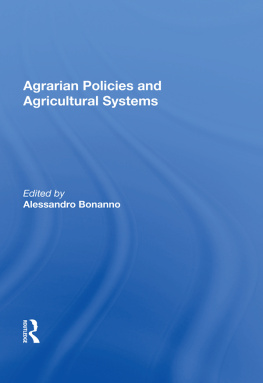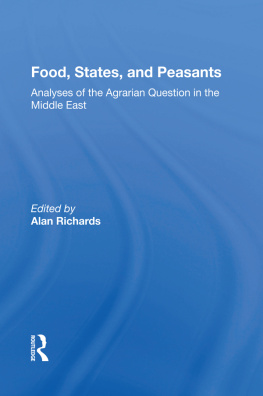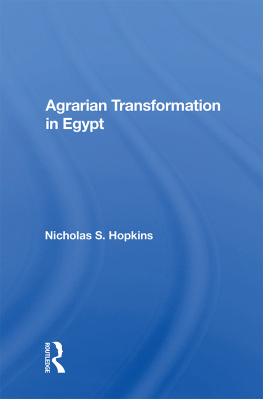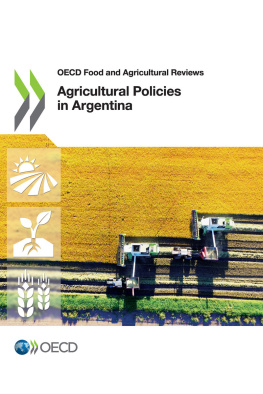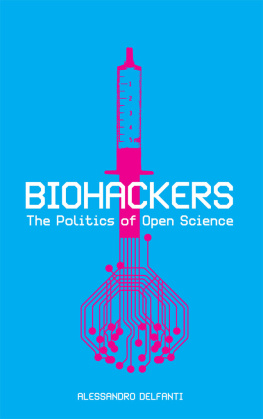Agrarian Policies and Agricultural Systems
First published 1990 by Westview Press
Published 2018 by Routledge
52 Vanderbilt Avenue, New York, NY 10017
2 Park Square, Milton Park, Abingdon, Oxon OX14 4RN
Routledge is an imprint of the Taylor & Francis Group, an informa business
Copyright 1990 by Taylor & Francis
All rights reserved. No part of this book may be reprinted or reproduced or utilised in any form or by any electronic, mechanical, or other means, now known or hereafter invented, including photocopying and recording, or in any information storage or retrieval system, without permission in writing from the publishers.
Notice:
Product or corporate names may be trademarks or registered trademarks, and are used only for identification and explanation without intent to infringe.
Library of Congress Cataloging-in-Publication Data
Agrarian policies and agricultural systems / edited by Alessandro
Bonanno.
p. cm.(Westview special studies in agriculture science and
policy)
Bibliography: p.
ISBN 0-8133-7730-7
1. Agriculture and stateUnited States. 2. Agriculture and
stateEuropean Economic Community countries. I. Bonanno,
Alessandro. II. Series.
HD1761.A57 1990
338.1873dc20
89-35019
CIP
ISBN 13: 978-0-367-01303-5 (hbk)
Contents
, Alessandro Bonanno
, Douglas H. Constance, Jere L. Gilles, and William D. Heffernan
, Antonio Fernndez Alvarez and Donato Fernndez Navarrete
, Donato Fernndez Navarrete and Antonio Fernndez Alvarez
, Michele De Benedictis, Fabrizio De Filippis, and Luca Salvatici
, Eduardo Moyano
, Alessandro Bonanno, Donato Fernndez Navarrete, and Jere L. Gilles
Guide
The idea of a comparative book on the agricultural policies and systems of the European Community and the United States developed during Professor Donato Fernndezs sabbatical visit to the University of Missouri campus in the Fall of 1987. Long discussions with Professor Fernndez enabled me to organize the project and identify the various fundamental components of the volume. Many thanks to Donato for his contribution to this project and for his assistance during all the phases of its development. I would also like to thank the other contributors for their excellent work and patience in dealing with my requests, deadlines, comments, etc. On their behalf I would like to thank those individuals both here in the United States and in Europe who assisted them in the preparation of the chapters. I wish to extend my appreciation to my secretary, Pat Nelson, for her assistance in the typing and printing of the final version of the manuscript. Finally, I would like to thank Heinz Woehlk for eliminating stylistic imperfections and errors from the book.
Alessandro Bonanno
Alessandro Bonanno
This study, prepared by a number of international scholars, is a comparative analysis of the agrarian policies and the agricultural systems of the European Community (EC) and the United States. It provides a critical overview of the agricultural policies of the EC and US, their stated objectives, their accomplishments, and their impact on both agricultural sectors.
Several considerations motivate the study of this topic. At the socio-economic level, confrontations between the US and the European Community in the agricultural and food markets have recently emerged. This situation is the outcome of the increasing production efficiency of both systems, which has resulted in the saturation of international food and agricultural markets and agricultural markets vis-a-vis a slower growing demand. Market outlets traditionally controlled by the United States have been penetrated by EC products, generating increasing tensions in the commercial sphere. This state of affairs has affected in turn the otherwise traditionally amicable and cooperative relations between Western Europe and the United States and prompted commercially restrictive measures which have been colorfully described as food trade wars. Though solutions to this problem are not among the objectives of this study, an elucidation of the characteristics of each system, their agricultural policies, and the objectives that they attempt to achieve provides information which may contribute to the resolution of the present commercial impasse.
Paradoxically, the growing agricultural commercial tensions between the European Community and the US are developing in a period in which the two systems have reached unprecedented levels of similarity. In the past decade the European Community has emulated the United States in terms of agricultural structure, raising levels of production and productivity, and is increasingly oriented toward the introduction of agricultural policies resembling those of the American model. Structurally, both the US and the EC are characterized by a dualistic pattern based on the existence of a very small number of large farms generating the bulk of production and a large number of small farms increasingly managed by part-timers. Simultaneously, in both continents medium-sized family farms are experiencing a decline and a reduced position in terms of both production and number of farms. At the productive level, in less than a decade increased production and productivity transformed the EC from a net importer of agricultural products to the second largest exporter in the world behind the United States. Furthermore, the lack of food self-sufficiency, which has characterized the European organization since its outset, has been greatly overcome in the Eighties to the point that now the EC is faced with a problem of agricultural overproduction similar to that of the United States. Indeed, overproduction has been cited as an important reason for alterations of the present EC agricultural policy, which is still characterized by a productivist posture. The constant increase in agricultural surplus stocks has made a policy resulting in expanding production and productivity untenable vis-a-vis perceived fiscal strains, new demands for rural development and environmental concerns. Accordingly, EC officials have turned their attention to US agricultural policies which through the years have been addressing the problem of overproduction. This convergence of policies, however, is taking place in a milieu in which fundamental historical differences with respect to the role of the government and its action in the socioeconomic sphere still strongly persist.
From the scientific point of view it is surprising that recent years have seen only a handful of comparative studies in the general area of agriculture. This situation stands in sharp contrast with the wealth of knowledge available at the levels of individual countries or groups of countries. Furthermore, this lack of comparative works comes at a historical juncture in which a globalized agricultural and food system is emerging. Accordingly, a contribution both to the limited comparative literature and to the analysis of the two largest food producing systems in the world appears relevant to the authors of this volume.
Politically, the commercial tension between the EC and the US, coupled with the world agriculture and food situation, begs for alternatives which address concerns of equity and justice while simultaneously tackling the issue of satisfaction of basic human needs. If political solutions are to be achieved, the analysis of present trends and possible alternatives assumes central stage. Indeed, the analysis of present trends assumes particular relevance in view of the current changes in Europe, changes characterized by the movement toward both an economic and political unification of the EC member countries and the collapse of the Eastern European communist bloc. The EC, then, is now faced with the challenge of becoming a unified entity and with the possibility of representing an ideological and political reference point for the liberation movements of Eastern Europe. In this context, it is not difficult to imagine a unified European state containing Eastern and Western nations constructed on the basis of the evolved EC multi-nation system.

